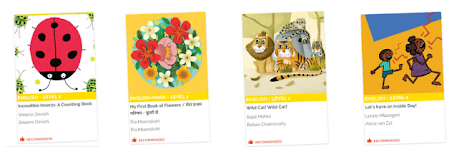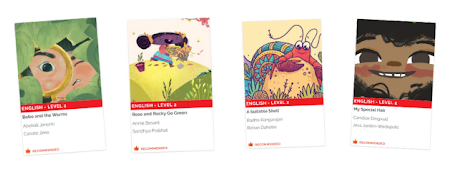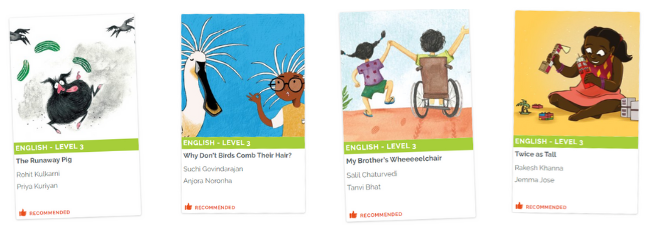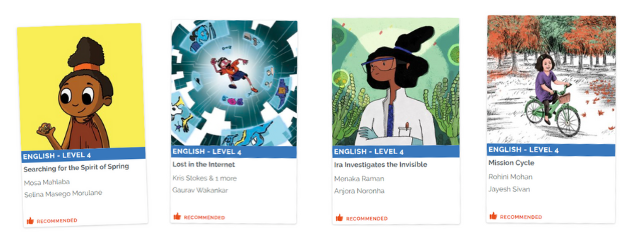70 Haryanvi Books created in our first ever Translation Hackathon
Posted by Sherein Bansal on February 21, 2018In the second week of February, a three-member team from Pratham Books visited Rohtak, Haryana to conduct a translation workshop with 25 teachers from 20 districts. Little did we anticipate the warmth and love we would receive from the participants who came from all over Haryana. But what was truly inspiring was that these teachers stayed overnight at the Government Senior Secondary School in preparation for this workshop. They were so self driven that they had explored StoryWeaver and made themselves a little familiar with it even before we entered the school premises.
The main aim of the workshop was to conduct a translation hackathon. This meant working with teachers to translate Pratham Books titles to Haryanvi on our digital platform, StoryWeaver. Every teacher translated at least three Level 1 and Level 2 books. But before that, they all took turns telling us about their favorite childhood stories that have stayed with them effortlessly, emphasizing the huge retentive power of stories.
Their welcome sign for us on the blackboard
It was exciting, the idea of translating children's books to their first language. Most of us won't question the existence of books in the languages that we first spoke at home. Not so much for anyone whose mother language is Haryanvi. The teachers speak it, but are not used to reading Haryanvi in books. Also, it changes its dialect with every district and even within a district. So the challenge was to translate stories in a way that's mostly uniform and can be understood by a child who belongs to any part of the state. The discussions that ensued among the teachers reflected their expertise in the language but also the mutual respect they had for each other's opinions. They reviewed each other's work in pairs and with the final feedback incorporated, every teacher enthusiastically read out their work to the whole class.
The most important appeal for everyone involved here was that in two days, this translation hackathon yielded a proper set of 71 Haryanvi books! More and more children across India, and specifically in Haryana, can now read stories in their own language.
During the workshop, we talked about the value of translation, the concerns behind it, and the importance of translating meaning to meaning instead of word to word, and from one cultural context to another. We talked about StoryWeaver, our open repository of children's books, and the ways they can use this platform in their classrooms for free to enable joy of reading among students. The teachers agreed that the essence of their language lies in its humour, and there was plenty of that for the time we spent with them!
After a delicious meal, we were ready to leave and bid farewell to the fresh air of the town when the teachers insisted that we stay a bit longer. Some teachers performed impromptu plays for us, some sang and others made us laugh.
It was truly a memorable workshop with every teacher an eager champion of Haryanvi in their own school and in their own district. And with that, the number of languages available on StoryWeaver rose to 107. There could have been no better way to ring in the International Mother Language Day.
Browse and read the Haryanvi stories on StoryWeaver.
comments (3)
Praba Ram and Sheela Preuitt - the translating duo
Posted by Remya Padmadas on September 30, 2017September 30th is celebrated around the world as International Translation Day. We're very fortunate that some of our wonderful translators and language reviewers shared their thoughts on translation and children's books with us on this occasion.
Praba Ram & Sheela Preuitt love stories of all sorts. Stories about children, about animals, about crafts, about travel, about science, about prehistoric life, about ancient cultures, and just about everything in our universe. As children’s authors, they find it a privilege to be able to translate works by other children’s authors and feel fortunate to be given the opportunity to do so with Pratham Books.
We love how Pratham Books goes beyond mainstream cities to include rural environments so as to make books that children in remote corners of India can identify with -- books that reach non-urban libraries, government schools, and small-town early learning centres, staying true to their mission of ‘A Book in Every Child's Hand’.
Translating children’s books involves not just taking the words from one language and putting it in another. Regional references, cultural nuances, idiosyncrasies of the language and local dialects, plus the vocabulary appropriate for the intended reading level all come into play, which makes it not only challenging but also extremely rewarding. While proficiency in both languages at a native level is a must, familiarity with the colloquial and idiomatic usage is a great plus as it helps make the work accessible to a diverse group of kids with varying backgrounds.
Emerging readers can easily be confused if the written format deviates too much from their spoken language and life experience. As translators, we strive to stay true to the original work by the author. However, where appropriate, we have also opted to strike a balance by bringing in an equivalent regional context that conveys the purpose and idea while swaying ever-so-slightly from the original presentation, primarily to engage the young readers in a meaningful way. In addition to overall stylistic and linguistic considerations of the original work, we also try to pay attention to the rhythm and flow in the translated language in order to enhance the read-aloud experience for the given reading level.
Often children's publishing in regional languages is influenced by ingrained beliefs and preconceptions prevalent in that region. Through quality books, Pratham Books has created a space for a body of literature for children that reflects the inter-connectedness of people, languages, and cultures, as well as their distinctive features, thereby breaking boundaries and providing books as a link from one region to another.
Translating a story across different languages brings varied voices together by offering a platform to celebrate cultural diversity and contemporary Indian realities and sensibilities, and we can only be delighted to partake in this meaningful linguistic movement - in fact, a grassroots one, so to speak.
And, seeing books in English translated not just to regional Indian languages but to Russian, Norwegian, Portuguese, even Japanese and Mandarin, reiterates that stories are universal and children around the world cannot have enough of them!
Be the first to comment.#TranslateAStory campaign: Translation tips and tutorials, answers to FAQs
Posted by Remya Padmadas on April 10, 2020The #TranslateAStory campaign will accelerate the creation of multilingual digital reading material, which will help children continue their learning journey at home, and give them access to books in languages they use and understand.
You can volunteer by translating a storybook (or books) on StoryWeaver. All you have to do is sign in to your StoryWeaver account and use our simple Translate tool - through this you will have access to thousands of delightful storybooks that you can translate
Here are the answers to FAQs, and the links to translation tutorials:
1. Who is eligible to participate?
Anyone who is fluent in two or more languages is urged to participate.
Individuals who are educators or translators, literacy organisations, education advocacy organisations, organisations working at the grassroots with native communities, university / college language departments or tribal departments, organisations working in language revitalization, language organisations, translation organisations, Bhasha Mandals - everyone is welcome to join the campaign.
2. Can we translate more than one book? Can we translate books into more than one language?
Yes! Every translation makes a difference.
3. I have no prior translation experience - is that okay?
It is absolutely fine if you have no prior translation experience - if you are fluent in two or more languages, you are all set!
Refer to our translation resources here, for some useful tips on the nuances of translating children’s storybooks.
4. How do I use the StoryWeaver Translate tool?
Here is a step-by-step guide on using the StoryWeaver Translate tool. You can check out our video tutorial here.
5. StoryWeaver doesn't have my language listed. Can I still participate?
Do write to us at [email protected]- we shall add your language to StoryWeaver, provided there is a Unicode compliant font for your language.
6. Is there prize money to be won?
This is not a contest, rather an invitation to volunteer our time and language expertise. There is no prize money.
7. How will I get credited for the book(s) I translate?
Once you create your own, individual account on StoryWeaver, this ensures that you receive an attribution for your translation.
8. There are 4 reading levels - what does this mean? Does it make a difference to the translation?
It is always good to keep the reading level of the child in mind while translating a storybook. Use the ‘filter by level’ option on the Translate page to browse and choose a book.
- Level 1: Storybooks for beginner readers. These books usually have short, simple sentences and don't have more than 1-2 sentences per page.

- Level 2: Storybooks for those who are learning to read, based on simple concepts. The books have short sentences and there are not more than 3-4 sentences per page. However you will find that some big but common words are used in these books.

-
Level 3: Storybooks for independent readers which have popular topics with well sketched out characters. The books have longer sentences, paragraphs and complex words.

-
Level 4: These stories are meant for those who can read proficiently and have nuanced storylines. The books have complex words, longer sentences and paragraphs. These stories sometimes contain language play like idioms, metaphors, similes, etc. Also words from other languages are introduced.

We hope this helps!
Looking for some inspiration for which storybooks to translate? Start here.
By submitting your translation to StoryWeaver, you are agreeing to a CC-BY 4.0 license being applied to it. Terms and conditions apply. For more read here.
For any other queries, do write to us at [email protected]